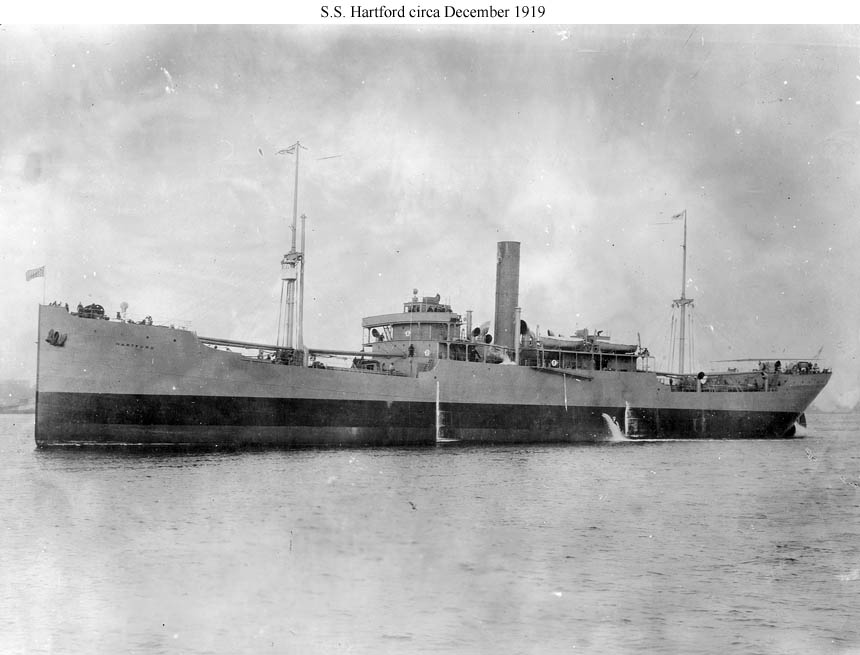EFC Design 1016 (Baltimore Dry Dock type):
Notes & Illustrations

Click here for a larger and more complete plan from the 1920 USSB ship register: Sheet 1
Click on the photographs below to prompt larger views of the same images.
|
Notes: As of April 1917 the Baltimore Dry Docks & Ship Building Co. consisted of an Upper Plant, formerly the William Skinner & Sons Shipbuilding and Dry Dock Company, and a Lower Plant, formerly the Columbian Iron Works and Drydock Company. As of July 1919 the Upper Plant was a 9.6 acre facility with one 200-foot slip on which minesweepers were being built, and the Lower Plant was a 13.5 acre yard where ten 6,200-ton cargo ships (six of them refrigerated), ordered by European and American interests and requisitioned by the EFC, were being built for the Shipping Board. On 12 March 1918 the EFC ordered 6,000 ton Design 1058 oil tankers to follow the cargo ships at the Lower Plant. The company was bought in 1921 by the Bethlehem Shipbuilding Corp. and the Upper and Lower Plants became its Key Highway or Upper Yard. Following U.S. entry into the war the EFC on 30 June 1917 ordered eight 8,800-ton cargo ships (EFC Hulls 192-199) from the Baltimore Dry Dock & Shipbuilding Co. To build these the firm acquired a tract of 36.5 acres where it built a new South Plant. This contained four 500-foot concrete building slips, two 70 feet wide and two 60 feet wide, that were design to turn out twelve 8,800-ton ships per year but could also build larger ships. The 8,800 deadweight ton Design 1016, Baltimore Dry Dock type, had specifications virtually identical to those of the Design 1013 Robert Dollar type except that it had longitudinal framing on the Isherwood system (which the firm also used in its 6,200-ton ships) instead of transverse framing. The first Baltimore Design 1016 ship, Naiwa, was laid down on 22 December 1917 and delivered on 30 October 1918, while the second, Fort Wayne, was laid down on 30 December 1917 and delivered on 23 December 1918. Having delivered these two ships by the end of 1918, the South Plant continued work on six more 8,800-ton vessels along with twelve 10,300-ton Design 1059 oil tankers which the EFC had ordered on 28 February 1918 to follow the cargo ships. In 1921 the South Plant became Bethlehem's Fort McHenry or Lower Yard. The EFC also ordered six Design 1016 ships (EFC Hulls 372-377) from the Groton Iron Works in Groton, Conn., on 11 August 1917. This yard was owned by Charles W. Morse of the United Steamship Co., who also owned the Virginia Shipbuilding Corporation. In April 1917 the Groton yard had purchased 26 acres of land opposite New London where it built the new steel shipyard that built the Design 1016 ships. On 20 April 1918 the EFC followed this order with one for six Design 1015 cargo ships (EFC Hulls 1542-1547, a type developed by the Moore Shipbuilding Co. of Oakland, Calif.), of which three were cancelled after the war. All of the Design 1016 ships from both builders were scrapped in 1929-30 with the exception of one in Japan in 1934. Specifications: Design 1016 (S.S. Naiwa, EFC Hull 192): Steel Cargo. Deadweight tons: 8800 designed, 8858 actual. Dimensions: 423.75' length oa, 410.5' pp x 54' beam mld. x 30' depth mld., 24.1' draft loaded. Propulsion: 1 screw, 1 G.E. turbine, 4 Heine water tube boilers, 2500 SHP, 10.5 kts. Configuration: 3-island, 2 decks, 4 holds, 5 hatches. |

| S.S. Hartford (Design 1016, EFC Hull 377), the last of the six ships of this type built by the Groton Iron Works, Groton, Conn., shown around the time of her completion in December 1919. (NHHC: NH 1350) (Click photo to enlarge) |




